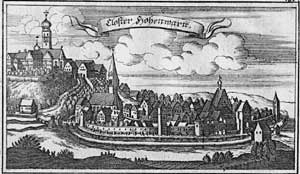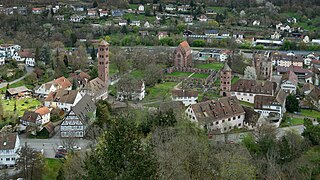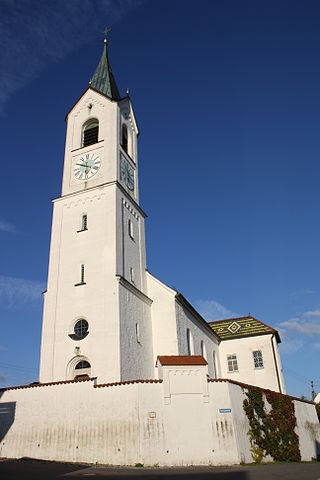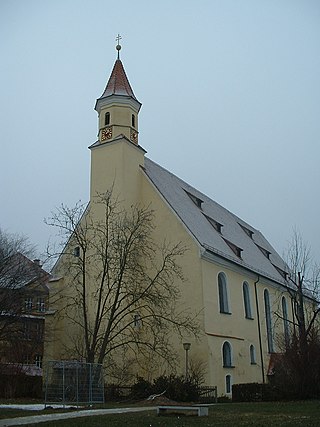Dillingen is a Landkreis (district) in Swabia, Bavaria, Germany. It is bounded by the districts of Donau-Ries, Augsburg and Günzburg, and by the state of Baden-Württemberg.
Günzburg is a Landkreis (district) in Swabia, Bavaria, Germany. Its capital is the town Günzburg. It is bounded by the districts of Dillingen, Augsburg, Unterallgäu and Neu-Ulm, and by the state of Baden-Württemberg.

Aufhausen Priory, formerly the Aufhausen Oratory, was a Benedictine monastery located at Aufhausen near Regensburg in Bavaria, Germany. It once again houses an Oratorian community.
Biburg Abbey was a Benedictine monastery located at Biburg in Bavaria, Germany.
Echenbrunn Abbey was a Benedictine monastery located at Echenbrunn, now part of Gundelfingen an der Donau in Bavaria, Germany.

Hohenwart Abbey was a Benedictine nunnery located at Hohenwart in Bavaria, Germany.

Hirsau Abbey, formerly known as Hirschau Abbey, was once one of the most important Benedictine abbeys of Germany. It is located in the Hirsau borough of Calw on the northern slopes of the Black Forest mountain range, in the present-day state of Baden-Württemberg. In the 11th and 12th century, the monastery was a centre of the Cluniac Reforms, implemented as "Hirsau Reforms" in the German lands by William of Hirsau. The complex was devastated during the War of the Palatine Succession in 1692 and not rebuilt. The ruins served as a quarry for a period of time.

Reichenbach Priory was a Benedictine monastery, located at Klosterreichenbach, now part of Baiersbronn in Baden-Württemberg in Germany.

Reistingen Abbey was a house of Augustinian canonesses, previously a Benedictine monastery, at Ziertheim in Bavaria.

Theres Abbey was a Benedictine monastery in the village of Theres in the district of Hassberge, in Franconia in the north of Bavaria, Germany.

Michelfeld Abbey was a Benedictine monastery in Auerbach in der Oberpfalz in Bavaria, Germany.
St. Stephen's Abbey, Augsburg is a Benedictine monastery, formerly a house of Augustinian canonesses, in Augsburg in Bavaria, Germany.

Wettenhausen Abbey was an Imperial Abbey of Augustinian Canons until its secularization in 1802–1803. Being one of the 40-odd self-ruling Imperial Abbeys of the Holy Roman Empire, Wettenhaussen Abbey was a virtually independent state. Its abbot had seat and voice in the Imperial Diet, where he sat on the Bench of the Prelates of Swabia. At the time of secularization, the Abbey's territory covered 56 square kilometers and it had about 5,400 subjects.

Elchingen Abbey was a Benedictine monastery in Oberelchingen in Bavaria, Germany, in the diocese of Augsburg.

Fürstenfeld Abbey is a former Cistercian monastery in Fürstenfeldbruck, Bavaria, Germany.

Oberschönenfeld Abbey is a Cistercian nunnery in Gessertshausen in Bavaria, Germany.
Ursberg Abbey is a former Premonstratensian monastery, now a convent of the Franciscan St. Joseph's Congregation, situated in the small village of Ursberg in the district of Günzburg, Bavaria.
Königsbronn Abbey was a Cistercian monastery in Königsbronn in the district of Heidenheim, Baden-Württemberg, Germany.
Roggenburg Abbey is a Premonstratensian canonry in Roggenburg near Neu-Ulm, Bavaria, in operation between 1126 and 1802, and again from its re-foundation in 1986. Since 1992 it has been a dependent priory of Windberg Abbey in Lower Bavaria. The monastery manages a training centre and a museum, and is widely known for its almost unchanged Baroque building and the organ concerts that are held in the church.

Söflingen Abbey was a nunnery of the Order of Poor Ladies, also known as the Poor Clares, the Poor Clare Sisters, the Clarisse, the Minoresses, or the Second Order of St. Francis. It was situated in the village of Söflingen, now part of Ulm in Baden-Württemberg, Germany. Being the oldest nunnery of this order in Germany, it was also its most important and most affluent.











